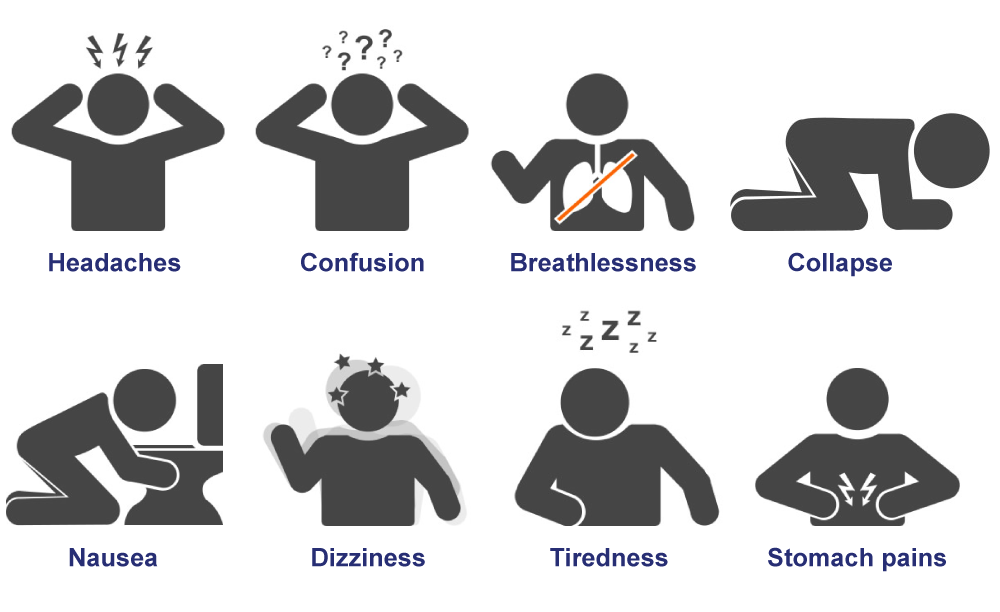


- #Carbon monoxide poisoning symptoms in babies how to#
- #Carbon monoxide poisoning symptoms in babies install#
- #Carbon monoxide poisoning symptoms in babies professional#
The above information is an educational aid only. Discuss treatment options with your child's healthcare providers to decide what care you want for your child. Learn about your child's health condition and how it may be treated. You have the right to help plan your child's care.
#Carbon monoxide poisoning symptoms in babies how to#
He or she needs to know how to get out of the house and where to go to find an adult. Teach your child what to do if the detector's alarm goes off. Place it 5 feet above the floor and away from fireplaces or gas-burning equipment.
#Carbon monoxide poisoning symptoms in babies install#
Install a CO detector in every sleeping area in your home.CPR may be needed if your child is not breathing. Start CPR if needed and you are trained on how to do this.Explain when the exposure happened and how long you think it lasted.
#Carbon monoxide poisoning symptoms in babies professional#
Wait for a professional to help you if you cannot do this safely. If safely possible, shut off the source of the CO. The following are steps to take if you believe your child is near a source of CO: If you think your child was exposed to CO, have him or her checked by a healthcare provider. What should I do if I think my child was exposed to CO?ĬO poisoning can seem like the flu. Your child will be in a room called a hyperbaric chamber during the treatment. The oxygen is given under pressure to help it get into his or her tissues and blood. Hyperbaric oxygen therapy is used to get more oxygen into your child's body.He or she may also get oxygen through small tubes placed into the nostrils. Your child may get oxygen through a mask. Extra oxygen may be given if your child's blood oxygen level is lower than it should be.Your child's heart rhythm and brain function may also be monitored. His or her breath may be tested for the amount of CO it contains. Your child may also need blood tests to check for problems caused by CO poisoning. Tell him or her if you use home heating devices that burn gas, oil, wood, or other fuel. Your child's healthcare provider will also need to know if your child was unconscious from the poisoning. Tell the provider if anyone in your home has similar signs and symptoms. Your child's healthcare provider will examine your child and ask about his or her symptoms. Difficulty speaking, chewing, or controlling facial muscles.Tremors or shaking, or trouble moving, bending arms or legs, or walking.Chest pain, or a fast, strong, or irregular heartbeat.Faster breathing than normal, or trouble breathing.Blurred vision, dizziness, or a headache.Your child may have any of the following:

Children often show signs of CO poisoning sooner than adults. Signs and symptoms may develop right after CO exposure, or several weeks later. What are the signs and symptoms of CO poisoning? Devices that are not vented, such as propane heaters, stoves, grills, or lanterns used inside a house, trailer, or tent.Gas-powered tools, vehicles, or machines used in poorly ventilated areas.Faulty devices or equipment, such as a furnace, water heater, gas stove, or wood-burning stove or fireplace.Severe poisoning can cause permanent injury or death. Your child's brain, organs, and tissues can be damaged from a lack of oxygen. CO can build up in your child's body and replace oxygen in his or her blood. Children younger than 4 years and unborn babies are especially at risk of CO poisoning. Children are at higher risk for CO poisoning because they breathe faster than adults. Exposure happens when a person breathes in CO. CO is a poisonous gas that you cannot see, taste, or smell. Last updated on Oct 1, 2023.ĬO poisoning is a life-threatening condition caused by exposure to high levels of CO.


 0 kommentar(er)
0 kommentar(er)
